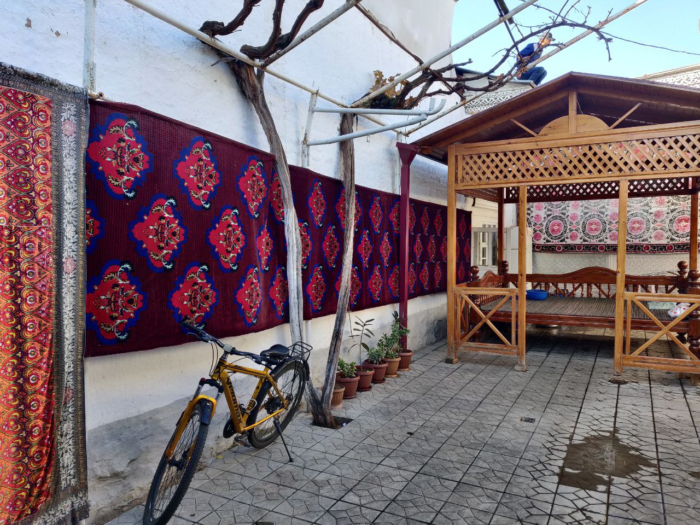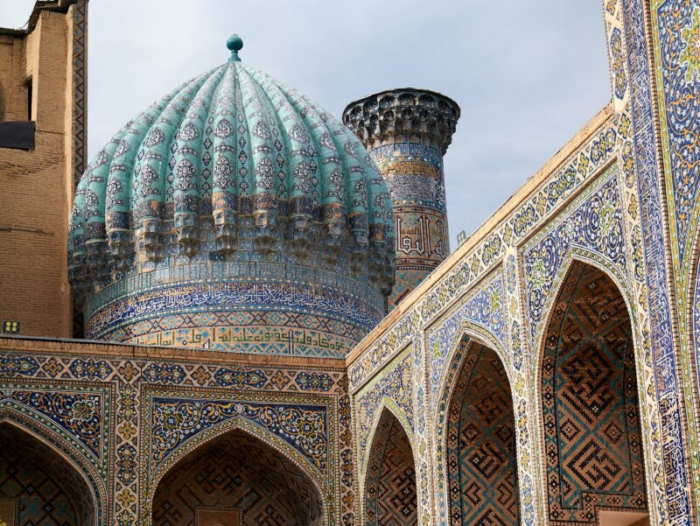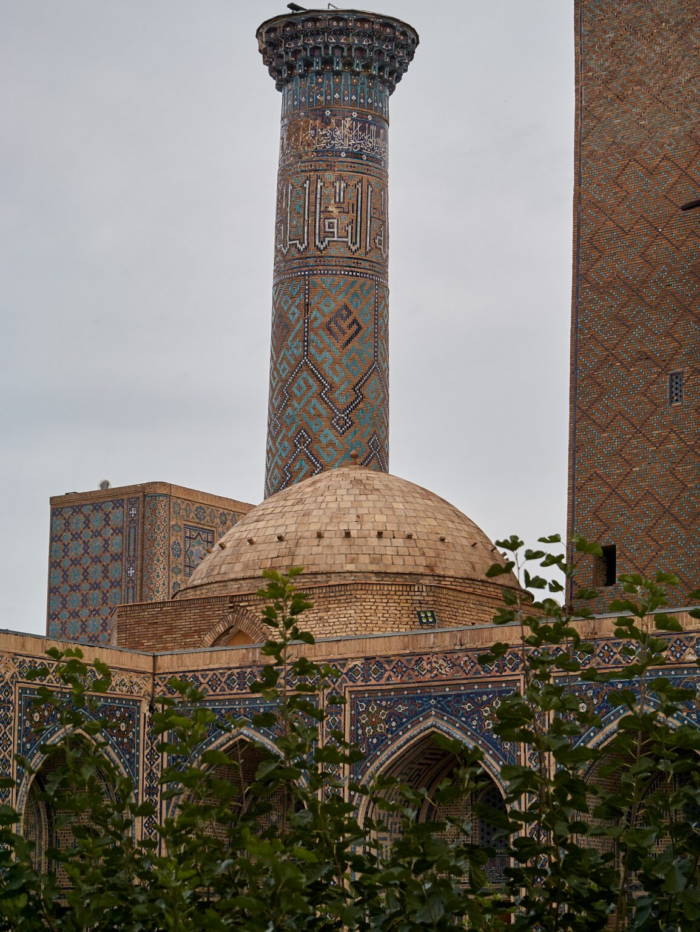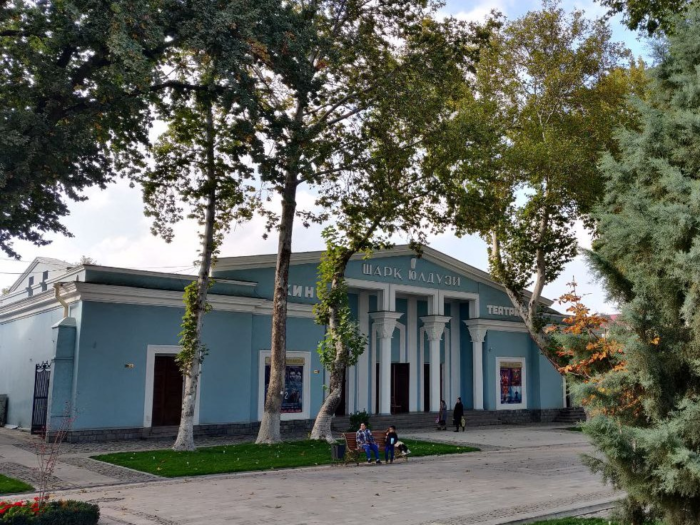
An ancient capital of the Timurid state, that spread across great spaces of Central Asia, appeared before me and my companions in 2022. The spirit of the Timurid Renaissance pervades the whole city center. Magnificent madrasah buildings on the main city square, Registan; Bibi-Khanym mosque; numerous domed mausoleums; the ruins of the ancient city of Afrosiyab – they are all famous traveling locations. At the beginning of the XV century, the status of the vast empire capital attracted a lot of money and masters to the city. At the beginning of the XXI century fashion for authenticity and antiquity attracted investments and tourists. I won’t go deep into history and won’t scrupulously describe the city — there are tons of books and travel guides. I’ll briefly stop on my impressions only.

Watching the Samarkand architecture as a layman, I noticed some influence of Iran and India. Building shapes, materials, domes, and pictures of tigers on facades remind of Iran; ornaments, specifically sun patterns look like an Indian influence.
The city center gives the idea that it was located at the crossroads of trading routes as well as that it was influenced by various cultures. The Great Silk Route passed right through it. Timur, Navoi (Uzbek-Iranian poet), and Ulugbek (a grandson of Timur and also a famous astronomer) gave their names to many geographic objects, and their images became city sculptures. As everywhere in Central Asia the city is pierced with a network of aryks — small aqueducts serving for both irrigation and drainage. Mainly the city consists of one-story houses with some small amounts of high buildings (shopping malls and business centers mostly). The city center and Zheleznodorozhny district differ from each other by their nature. While all the sights and authentic districts with small houses and narrow streets are in the city center, in the Zheleznodorozhny district there are lots of high buildings, cafes, and restaurants, some of them even serve something apart from traditional plov, samsa, and grilled meat.

Surprisingly there are traffic jams even in such a small town having only small buildings and wide three-lane roads in the city center. This is a common problem in Uzbekistan. While the Uzbeks are a friendly and polite nation as a whole, the driving culture is really low here. Drivers can create a traffic jam out of literally nothing.

On the whole, the city makes a nice impression, it’s very green – it is probably greener than Tashkent. That’s why it’s better here with the quality of the air. At no time have I seen drunk people on the streets. However, instead one can easily cross paths with aggressive gypsies. Once I was an observer of such a scene: a group of local men passed a bridge and met several female gypsies that started to harass them and extort money. They even manage to pull a cap out of one man’s head, and this man needed to fight for it, giving money to one of the offenders in the process. Apart from that, Samarkand is seemingly a safe town.

From talks with locals, I got to know that up to 90% of marriages are arranged by the parents of couples so you can hardly consider the marriages love-based. The pressure on families is huge. That is the reason why divorces are relatively rare – even if people are sick and tired of each other, they will probably be afraid of getting a divorce because of the reactions of their families and neighbors, the complicated divorcing process, and their religious beliefs. All in all, the cult of a big family is strong in Uzbekistan (I heard the same about neighboring Kyrgyzstan) – people often go to other countries and cities for jobs, but they either come back home later or move their whole big families together with the parents and other relatives. Couples planning to have no less than two kids, usually 3-4. In generations 40-50 years old it was still ordinary to have around 10 siblings, but today the situation changed. However, there’s still a long way to go until the Second Demographic Transition point is reached as there are almost no couples who want to have two or fewer kids, this is not the norm. Many parents try hard to provide their kids with a decent education. Many people zero in on getting a job in the US, the EU, the UK, or Russia. Teaching at schools is often in the Russian language, and each district has many private schools with English lessons. In addition to that, there are a lot of Arabic, Turkish, and Korean language courses. Green card ads are everywhere in the city, there are no fewer ads like that than in Tashkent. Speaking about the cult of big families, there are two huge wedding ceremonies: the first one is for the same gender people only and another one for everybody else. People take credit for a wedding party, as it’s very expensive entertainment. Usually, there are several hundred guests.

Samarkand is not the capital, there are not many services that are common in Tashkent. One can hardly pay with a payment service, taxi drivers take cash only. However, Yandex Taxi aggregator has been operating for a couple of years. There are concerts, and conferences in the city, and a big business cluster is built near the renovated rowing canal. Rowing international competitions on the canal, and the business center hosts guests from prominent organizations such as SCO. In the vicinity of the rowing canal, there’s an impressive musical fountain.


Samarkand unites the past (of the Timurid capital) and the present (as a business and cultural center) – and this is not a phrase from some ads, but a reflection of reality. Respect for the past and pursuit of the future was illustrated by a concert of a new Russian band singing in English. This concert was held as a part of events supporting the Samarkand semi-marathon. The band played right in the center of the beautifully lit central city square, surrounded by three monumental madrasas of the Timurid era.






Interestingly, there are still some late Russian empire and Soviet houses in the center of Samarkand.













